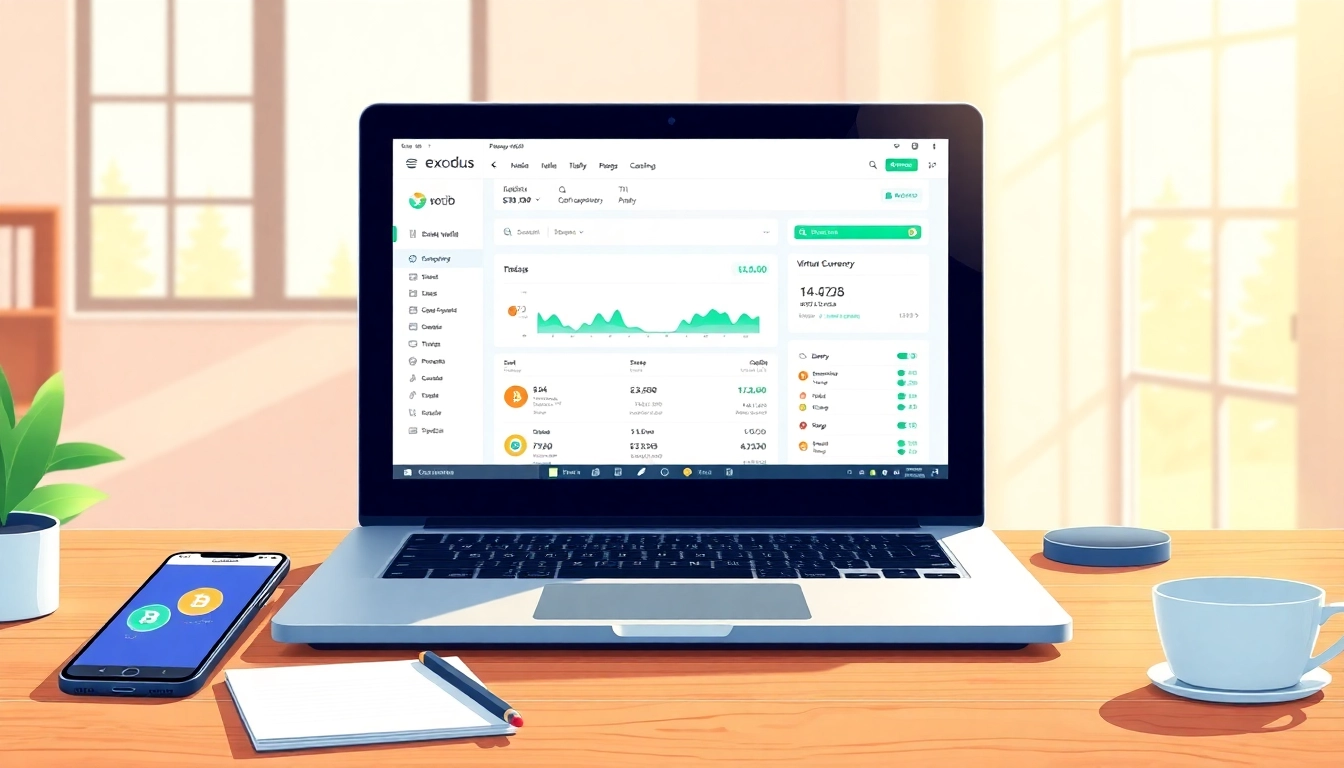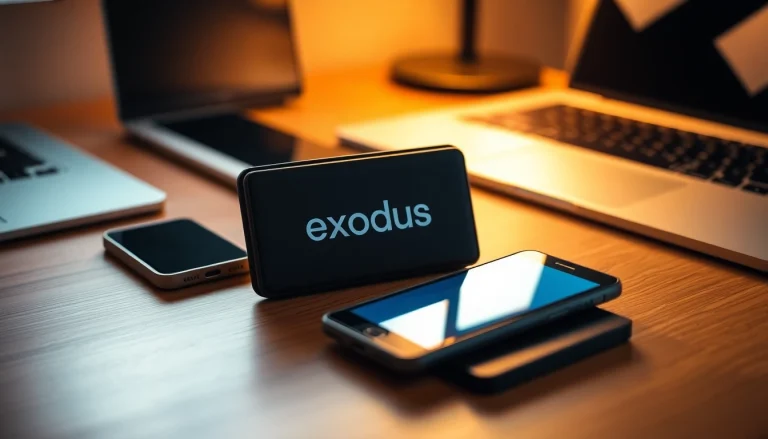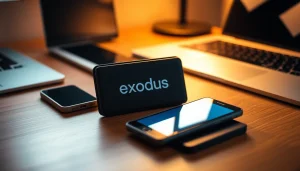1. Understanding the Exodus Wallet: A Beginner’s Overview
What is the Exodus Wallet?
The exodus wallet is a popular cryptocurrency wallet designed for both beginners and experienced users. Launched in 2015, Exodus provides a user-friendly interface that allows you to manage a multitude of cryptocurrencies in one place. Unlike traditional banking services, Exodus empowers users to have complete control over their assets. As a hot wallet, it is connected to the internet, providing ease of access at the expense of certain security vulnerabilities inherent to online storage solutions.
Exodus supports over 100 cryptocurrencies, including Bitcoin, Ethereum, and Litecoin, and features a built-in exchange service for swapping between different coins at competitive rates. Notably, it does not require users to undergo a lengthy registration process, making it optimally convenient for new users initially diving into the world of cryptocurrencies.
Core Features of the Exodus Wallet
- User-Friendly Interface: Exodus stands out for its aesthetic design and intuitive navigation, making it easy for users to view and manage their cryptocurrency holdings.
- Built-In Exchange: Allows for seamless trading between cryptocurrencies without needing to transfer funds to an exchange platform.
- Multi-Currency Support: Users can store and manage a diverse portfolio of over 100 digital assets.
- Built-In Wallet Security: Exodus offers private keys stored locally on the user’s device, ensuring full ownership and control of their assets.
- Customer Support: An active support team along with an extensive knowledge base guides users through any challenges they might encounter.
Comparing Exodus Wallet with Other Crypto Wallets
When looking at the broader market, Exodus compares favorably against various wallets, both hot and cold. Unlike hardware wallets like Ledger or Trezor that offer higher security by being disconnected from the internet, Exodus provides significant convenience for users who frequently trade. In contrast to more complex wallets like MetaMask, which primarily focus on Ethereum and ERC-20 tokens, Exodus provides diversity in asset management. While Exodus does offer security measures such as a backup feature and recovery phrase, novices should always be aware of inherent risks associated with hot wallets.
Ultimately, Exodus caters to users who prioritize usability and flexibility over maximum security, making it an excellent starting point for those new to managing cryptocurrency.
2. Setting Up Your Exodus Wallet Account
Step-by-Step: Creating Your Exodus Wallet
Creating an Exodus wallet is a straightforward process. Follow these steps to get started:
- Download the Wallet: Visit the official Exodus website or search for the Exodus app on the App Store or Google Play Store.
- Install the Application: Follow the prompts to install the software on your desktop or mobile device.
- Create Your Wallet: Upon opening the app, a wallet will be automatically generated for you, with a recovery phrase displayed on the screen.
- Backup Your Wallet: Write down the recovery phrase and store it securely; this is essential for restoring your wallet if needed.
- Customize Your Settings: Adjust the settings according to your preferences regarding alerts and notifications.
Configuring Security Settings for Your Exodus Wallet
Security is vital for any digital asset management tool. Exodus provides several features to enhance your wallet’s security:
- Backup Your Wallet: Regularly back up your wallet to secure your funds; use the recovery seed phrase as your key to restoring access.
- Set Up a Password: Set a strong password for an additional security layer that protects your wallet when it is opened.
- Enable Two-Factor Authentication (2FA): While Exodus itself does not support 2FA directly, users can enable it on third-party exchanges linked to their Exodus accounts.
Adding Cryptocurrencies to Your Exodus Wallet
To enhance your digital portfolio, adding funds to your Exodus wallet is essential. You can add cryptocurrencies in multiple ways:
- Receive Cryptocurrency: To receive coins, generate a receiving address within the wallet for specific currencies and share this address with the sender.
- Buy Cryptocurrency Directly: Exodus partners with third-party services allowing users to purchase cryptocurrencies directly with debit/credit cards.
- Exchange Other Cryptocurrencies: Use the built-in exchange feature to swap between cryptocurrencies without needing to leave the app.
3. How to Use the Exodus Wallet Effectively
Managing Cryptocurrencies with Your Exodus Wallet
Once your Exodus wallet is set up and funded, managing your cryptocurrencies efficiently is crucial. The dashboard allows users to view balances and track the value of assets in real-time. Users can categorize or sort their currencies by type to keep better track of portfolios, making it easy to monitor performance over time. Additionally, Exodus provides charts for users to assess the growth or decline in the value of their assets.
Swapping and Trading on the Exodus Wallet
The ability to swap currencies within the Exodus app simplifies the trading process. Users can choose between different currencies and exchange them at competitive rates with just a few clicks. The user-friendly interface helps newcomers navigate trading easily, while seasoned pros can capitalize on opportunities without having to navigate separate exchange platforms. Keep in mind that while swapping through Exodus can be convenient, users must also be aware of transaction fees that apply.
Using the Exodus Wallet for Passive Income
Exodus offers various avenues for earning passive income on your holdings. Users have opportunities to stake supported currencies directly in the app. By staking, users help validate transactions on blockchain networks while earning rewards in the form of additional coins. This method benefits both the user and the network, making it an attractive option for those who want to grow their investments with minimal effort. It’s important to research which currencies or tokens can be staked within Exodus to maximize earning potential.
4. Common Challenges and Troubleshooting with Exodus Wallet
Security Issues: What to Watch Out For
While Exodus prioritizes security, users should remain vigilant. Common security considerations include:
- Phishing Attacks: Be cautious of unsolicited emails or messages claiming to be from Exodus. Always verify the URL before entering any personal information.
- Private Key Management: Never share your private keys or recovery phrases with others. Storing this information securely offline is advisable.
- Secure Your Device: Ensure your computer or mobile device has up-to-date antivirus and anti-malware software to prevent unauthorized access.
Addressing User Concerns about Exodus Wallet Fees
Users sometimes express concerns about fee structures associated with the Exodus wallet. Transaction fees can vary based on the network congestion and the specific cryptocurrency being traded. Additionally, when swapping coins, users may notice a difference in exchange rates, which essentially includes a spread. To minimize costs, users should consider timing their swaps during off-peak periods when network fees are lower.
Recovering Access to Your Exodus Wallet
If ever locked out of your wallet, recovering access is a straightforward process, provided you have noted your recovery phrase. Simply reinstall the app, open it, and choose the option for wallet recovery. Enter your recovery phrase accurately, and your wallet will be restored, along with all associated funds and assets.
5. Future Trends in the Exodus Wallet and Cryptocurrency Landscape
Upcoming Features to Look for in Exodus Wallet
The cryptocurrency landscape is ever-evolving, and Exodus is continuously working to innovate. Future updates could include:
- Enhanced Security Features: More robust measures to prevent unauthorized access and facilitate safer third-party service integrations.
- Broader Support: Continued expansion of supported assets, allowing users to manage a wider array of cryptocurrencies.
- Advanced Trading Options: Introduction of tools for more sophisticated trading strategies, appealing to experienced traders.
The Role of Exodus Wallet in Decentralized Finance (DeFi)
As decentralized finance grows, wallets like Exodus may play a pivotal role by providing users with access to DeFi protocols directly from their application. This could enable users to lend, borrow, and earn interest on their cryptocurrencies without intermediaries. Being a multi-currency wallet, Exodus is positioned well to benefit from the expanding DeFi trends.
Preparing for Changes in Crypto Regulations Affecting Exodus Wallet Users
Changes in global cryptocurrency regulations could impact wallet operations. Exodus and other wallets are likely to adapt by implementing compliance features to meet regulatory standards. Users should stay informed and prepared to manage their assets in line with potential rule changes or requirements that may arise as the regulatory landscape develops.






